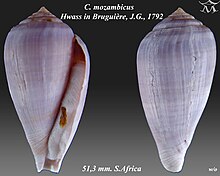Species of sea snail
| Conus mozambicus
|
![]()
|
| Apertural and abapertural views of shell of Conus mozambicus Hwass in Bruguière, J.G., 1792
|

|
Scientific classification 
|
| Domain:
|
Eukaryota
|
| Kingdom:
|
Animalia
|
| Phylum:
|
Mollusca
|
| Class:
|
Gastropoda
|
| Subclass:
|
Caenogastropoda
|
| Order:
|
Neogastropoda
|
| Superfamily:
|
Conoidea
|
| Family:
|
Conidae
|
| Genus:
|
Conus
|
| Species:
|
C. mozambicus
|
| Binomial name
|
Conus mozambicus
Hwass in Bruguière, 1792
|
| Synonyms[1]
|
- Conus (Floraconus) mozambicus Hwass in Bruguière, 1792 · accepted, alternate representation
- Conus altispiratus G. B. Sowerby II, 1873
- Conus caffer Krauss, 1848 (invalid: junior homonym of Conus caffer Röding, 1798)
- Conus informis Hwass in Bruguière, 1792
- Conus lautus Reeve, 1844
- Conus macei Crosse, 1865
- Conus mozambicus lautus Reeve, 1844
- Conus mozambicus mozambicus Hwass, 1792
- Sciteconus mozambicus (Hwass in Bruguière, 1792)
|
Conus mozambicus, common name the Mozambique cone or the elongate cone, is a species of medium-sized sea snail, a predatory marine gastropod mollusc in the family Conidae, the cone snails or cone shells.[1]
Distribution
Conus mozambicus cone is known off the southern African coast from Lüderitz Bay to Mossel Bay, subtidally in shallow water. The species is endemic to this region.[2] It is also found off Senegal and Mozambique.
Description
Conus mozambicus has a medium-sized shell which may grow to 65mm in total length. It has a sharply pointed spire. The shell colour is dull and mottled with brown, and there may be darker blotches at the shoulder. The spire of the shell is stepped.[3]
Ecology
Conus mozambicus feeds on polychaete worms. The egg capsules are vase-shaped and contain 19-23 eggs.[2]
References
External links